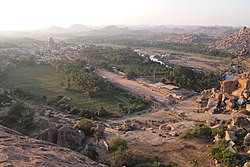Hampi Vijayanagara | |
|---|---|
 | |
| Coordinates: 15°20′06″N76°27′43″E / 15.335°N 76.462°E | |
| Country | |
| State | Karnataka |
| District | Vijayanagara |
| Elevation | 467 m (1,532 ft) |
| Population (2011) | |
• Total | 2,777 [1] |
| Languages | |
| • Official | Kannada |
| Time zone | UTC+5:30 (IST) |
| PIN code | 583239 |
| Nearest city | Hospet |
Hampi is a city in the Vijayanagara district in the Indian state of Karnataka. [2] Located along the Tungabhadra River in the east and center part of the state, Hampi is near the city of Hospet. It is famous for hosting the Hampi Group of Monuments with the Virupaksha Temple, a UNESCO World Heritage Site. [3] The city was possibly known as Kishkindha in the Ramayana age.
Contents
Hampi is mentioned in Ashokan epigraphy and texts such as the Ramayana and the Puranas of Hinduism as Pampaa Devi Tirtha Kshetra. [4] [5] [6] Hampi was a part of Vijayanagara, the capital of the Hindu Vijayanagara Empire in the 14th-century. [4] [7] It became a center of economic and administrative activity of the Deccan region kingdom founded in opposition to Islamic Sultanates in South India. After over two centuries of rule, the Empire was defeated and abandoned. Since the 19th-century, its ruins have been an important site for archaeologists and historians. [7] [8]
